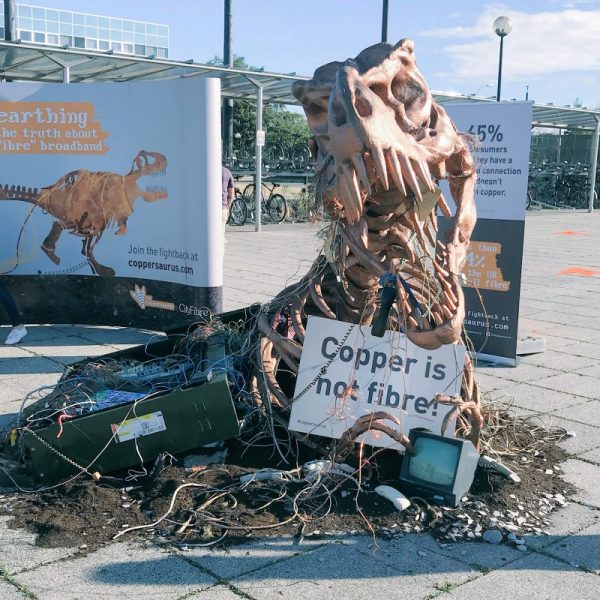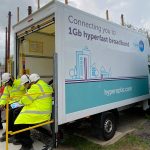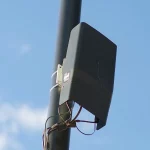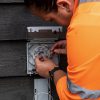Ofcom UK Clamps Down on Misleading Uses of “Fibre” Broadband UPDATE2

Good news. The UK telecoms regulator, Ofcom, has today proposed new guidance that would only allow broadband ISPs to use the terms “fibre” and “full-fibre” on their websites and in contracts “if their network uses fibre-optic cables all the way from the exchange to the home” (i.e. FTTP).
As we’ve previously reported, numerous broadband ISPs have spent the best part of the previous decade selling slower “part-fibre” or “hybrid-fibre” (e.g. FTTC / VDSL2, G.fast, Hybrid Fibre Coax) solutions as “fibre broadband” products, which is one of the reasons why so many people continue to be confused about the terminology today (i.e. if you think you’ve got it already, then you may be less likely to contemplate an upgrade).
In the past, there have been various attempts to correct this, such as via a review conducted by the Advertising Standards Authority (here) and a failed court challenge by CityFibre (here). Back in 2021 the Gigabit Take-Up Advisory Group (GigaTAG) also proposed several changes (here), including clearer labelling of broadband packages to help consumers understand the differences. But until now there hasn’t been a concrete change.
Advertisement
However, Ofcom recognises that the way fixed broadband services are delivered is changing, not least with respect to the national rollout of gigabit-capable Fibre-to-the-Premises (FTTP) networks that offer many advantages in terms of speed, latency, reliability and so forth.
As such, the regulator has finally decided to underline the importance of this by ensuring that consumers are getting the most useful and correct information, which they’re going to do by addressing how the term “fibre” is “used inconsistently” to apply to both new and older networks. Took them long enough.
Ofcom’s Proposal for Fibre Terminology
We are consulting on guidance under General Condition C2.3 and General Condition C1 that providers should:
• Include a short description of the underlying technology of the network delivering the broadband service, on their websites and in contract information, using one or two terms such as ‘fibre’, ‘cable’, ‘full-fibre’, ‘copper’ or ‘part-fibre’.
• Use those terms consistently to describe the service.
• Only use the terms ‘fibre’ and ‘full-fibre’ when referring to fibre-to-the-premises networks.
• Provide an explanation of the one- or two-word terms used to describe the service, in a way that can be easily accessed by customers.
As part of this, the regulator highlighted some results from its own survey, which found that only 46% of customers who reported being on full-fibre broadband were living in areas where it is actually available and 27% lacked confidence in understanding the language and terminology used by ISPs. Some 53% also said, when choosing a broadband service, that it would useful to have a short description of the underlying technology used to deliver their services.
Selina Chadha, Ofcom’s Director of Connectivity, said:
“It’s vital that customers are provided with the right information to help them choose the best broadband service for them. But some of the industry jargon used to describe the underlying technology supporting their broadband service can be unclear and inconsistent, meaning customers are left confused.
So today we’re proposing to introduce new guidance to ensure that broadband firms give clearer, straightforward information about their services – making it easier for people to take advantage of more reliable, and potentially higher speed technology, as it becomes available.”
The new proposals cover residential and small business services, but Ofcom clarifies that they “do not cover advertising“, but they do cover point-of-sale information and contractual information. Advertising, including online advertising on companies’ own websites, falls within the remit of the Advertising Standards Authority (ASA). Nevertheless, Ofcom’s move will place pressure on the ASA to follow suit.
Advertisement
In 2017 the ASA concluded that it was NOT materially misleading to describe broadband services that use fibre-optic cables for only part of the connection to consumers’ homes as “fibre broadband“, while also claiming that it had little to no impact upon the decisions that consumers were making.
The ASA’s position reflected the problem of trying to change an approach that has long since become established in the consumer subconscious, where the meaning of “fibre” has been diluted over years of use (or misuse) alongside slower hybrid (part) fibre technologies. In fairness, though, most consumers still seem to pick a package based more on a combination of price, speed and quality than a specific technology.
The proposals form part of Ofcom’s related consultation, which will remain open for feedback until 5pm on 3rd May 2023. The regulator then plans to publish a statement in Autumn 2023.
UPDATE 3:05pm
Advertisement
The comments are starting to come in.
Jarlath Finnegan, CEO of Giganet, said:
“At a time where there is significant investment in fibre infrastructure across the UK, many customers are gaining access to full fibre broadband for the first time, so we welcome this timely announcement that Ofcom is going to ensure that customers get much clearer and consistent information when they are signing up to a new provider.
There continues to be confusion around whether it’s super-fast, ultra-fast, full or part fibre. The new guidance will help customers take advantage of the best broadband available and strengthen the case for more accelerated investment in full fibre infrastructure.
At Giganet, we offer full fibre services only as it’s the best way to ensure customers at home and in business have consistently reliable internet services.”
Greg Mesch, CEO of CityFibre, said:
“Millions of consumers have been mis-sold broadband products for too long. They have been sold internet connections that still use outdated, slow and unreliable copper networks but have been advertised as ‘fibre’ connections.
Ofcom is clear that full fibre is better broadband, and we look forward to it stamping out this practice so that consumers can no longer be misled.”
UPDATE 9th March 2023
James Warner, CSO of FullFibre, said:
“After years of suffering confusing jargon, customers can now breathe a sigh of relief that there will be some clarity when it comes to what they might actually be getting when they buy broadband. It has taken far to long for Ofcom to announce this, and it won’t come into force until the autumn, at the earliest, so a few more months of miss-leading the consumer left and then we can all be clear on what Fibre actually is.
Hopefully this is the start of some clarity and consistency across the sector, which won’t just help the consumer, but start to de-mystify something that should be simple and for the benefit of all.”
Mark is a professional technology writer, IT consultant and computer engineer from Dorset (England), he also founded ISPreview in 1999 and enjoys analysing the latest telecoms and broadband developments. Find me on X (Twitter), Mastodon, Facebook, BlueSky, Threads.net and Linkedin.
« Over 100 Bolton Residents Protest 50ft IXWireless Broadband Mast






















































wow finally after decades
SO WILL Virgin media have to change the fibre in they website and stuff as they us TV cables lol (docsis)
Yes, as will BT and everyone else using FTTC, and Hyperoptic where they’re using FTTB.
I wonder what that means for FTTB players such as Hyperoptic? I mean it isn’t fibre all the way to the home, only to the basement, at least for most of their homes passed…
Technically that can still be classed as FTTP as it is to the premises itself, despite the fact a Cat5E cable is used to get it to the dwelling itself. I think this is more for those where fibre isn’t actually delivered to the premises itself like FTTC or Cable.
Worth pointing out that Hyperoptic is a mix of FTTB and FTTP too. I’m not sure how much FTTB plays a role in their more recent builds, but it may depend upon the building / MDU too.
A residential premises is in the individual living unit, so FTTB is not FTTP.
https://www.landmarkchambers.co.uk/wp-content/uploads/2020/02/What-is-a-flat-and-what-is-a-building-TJ-and-KZ.pdf
It is a good point.
But IRL Hyper can deliver 1Gb that looks and measures like 1Gb over FTTB using Cat5e.
But yes, it does make the historical decision to use FTTB look a bit more shaky. But and it is a big but it was about expediency as to start with there were very few fibre jointers and splicers about. And I have always believed this decision was driven by it being easier to terminate Cat5e also for a long time the active splitters, before PON’s, were much, much more expensive than a 1Gb router with a 10Gb port to feed it.
So I can see why it was done even if it wasn’t fully future, or ASA/OFCOM proof.
If I were hyperoptic I’d advertise full fibre and argue the toss with ofcom if they complain.
Cat5e can do 2.5Gbe full duplex over 100m and 5Gbe/10Gbe over shorter distances. I’m not sure that I’m sold that it’s not “future proof”.. practically that’ll be fine for the next 20 years and those cables will have been in a minimum of 5 years by now.
I would have thought that the salient part of whether a connection can be thought of as “Full-fibre” or not, should be the part of the connection that is actually within the remittance of the ISP.
As far as I’m aware (please correct me if I’m wrong), the final copper run within a given apartment building is owned by the property management company that owns that building and not the ISP itself. Therefore, to expect the ISP to guarantee a fiber connection all the way to the apartments themselves, seems somewhat unreasonable – especially in the case of management companies that (quite reasonably) don’t see the benefit of shelling out 10x the cost, for actually no benefit whatsoever (as of today).
On the other hand, FTTC, where a substantial part of the physical connection controlled by the ISP *isn’t* actually fibre at all, should not be considered a fibre connection, nor should hybrid coax schemes.
“As far as I’m aware (please correct me if I’m wrong), the final copper run within a given apartment building is owned by the property management company that owns that building and not the ISP itself”
You’re wrong.
Hyperoptic used to install fibre to the basement/comms cupboard and then cat5e to each apartment.
They changed deployment method and now use fibre instead of cat5e for the run from basement to apartment.
Hyperoptic own and maintain the wiring between basement and apartment on the vast majority of their deployments.
This should happen back in 2007. It a joke it taken this long.
Totally agree.. what a farce
Precisely. And the previous ASA decision was just capitulation to false advertising, which long term just added to the consumer confusion.
Needed to drag it out so Openreach could sweat the assets. Now the FTTP rollout is in full flow they can just ignore previous decisions and switch back. Absolute joke.
Sounds about right. OfCom is a subsidiary of BT, after all.
I wonder if there was some whispers from the big boys wanting this change because customers already believe they are on fibre and aren’t rushing to upgrade to real fibre?
I’m sure there was, Jack. CityFibre and the altnets would be all over it and I speculate that the tipping point has been BT getting on board so that they can more easily sell FTTP and get punters off copper.
Taking the hit on their FTTC no longer being ‘fibre broadband’ in return for FTTP uptake: smart.
Exactly this. Because We’re about the have fibre installed the street and I asked my mom and dad if they were going to upgrade and the said “No, we already have fibre”
Had to explain to them the difference and they were still confused lol.
Exactly
Now that both the big boys OR and VM have FTTP plans there is no milage on pounding the Fibre = Hybrid misleading nonsense anymore.
This is as much to do with OR *wanting* to retire the copper network as anything else.
At least it makes sense from a business and consumer point of view: for once!
About flippin’ time.
The horse has already bolted,
Labour say they will reverse this change if they get into power.
Labour also said they would nationalize broadband. As much flipflopping as in the definition of the basic word woman
They do not know what they are doing
where did they say this?
The failure to get to grips with the difference between ‘throughput’ where the speed of light is treated as a constant; and super -giga, ultra, hyper, faster than the SOL, where Government, Ofcom, Network Providers and ISP advertising have treated the SOL as a variable for the last 15 years should be dealt with.
‘Full fibre’ on its own may not serve the industry well.
Full fibre has more ‘throughput potential’ which is a wonderful property to possess. It does not mean the customer gets all that potential. Customers get only what they pay for based on what they think they need. This is bound by what the supplier provisions for the peak hour and the packet loss and jitter characteristics associated with that service.
‘Future proof with full fibre’ might have more meaning than ‘full fibre’.
“ The failure to get to grips with the difference between ‘throughput’ where the speed of light is treated as a constant; and super -giga, ultra, hyper, faster than the SOL, ”
You’re aware the speed of light changes when light passes through different mediums.
In a vacuum, like space, electro magnetic radiation like Radio frequencies or light travel at the same speed.
https://www.qrg.northwestern.edu/projects/vss/docs/communications/2-why-does-it-take-so-long.html
Not sure what point you’re trying to make re throughput. Ultimately the light in the fibre needs to go through some metal and converted into something a cpu can process.
Truly not sure where you’re going with that throughput statement, are you suggesting fibre has more throughput than copper?
Fibre can transmit data further as the signal retains quality/definition over longer distances, it degrades less over distance. runs of copper can be just as fast as fibre, depends how far you want to go.
@Chris, full fibre has the potential to deliver more throughput not more speed.
From a user experience perspective once the access line is delivering a throughput of 30-80Mbps the incremental benefit of more throughput is nice to have but has little impact on the user experience. Most of the benefits of full fibre accrue to operator in the form of cheaper operational costs.
In the context of reaching full fibre, it is likely at some point industry will attempt to induce limitations into FTTC services in order to encourage take up of full fibre.
@nga, I assume your Fibre for all
“ Throughput is a measure of how many units of information a system can process in a given amount of time. It is applied broadly to systems ranging from various aspects of computer and network systems to organizations.”
You are confusing throughput and speed.
Throughput is analogous to speed, more bits on the medium per second = faster speed. More complex encoding per bit = even more speed for the same bit rate. Better transceivers and codecs on the medium can transmit or receive more data within a time frame which is speed.
Amount of stuff in a given time = speed.
A road with 5 lanes can accommodate more cars than a 2 lane road = more throughput.
Fibre cables are optimised for specific wavelengths of light, copper can convey more rf frequencies, ie more lanes.
Copper/fibre/air all have potential for faster speeds.
The reason for using fibre is that you get less degradation of signal over distance so the transceivers can process more bits without error.
So has Ofcom the power to overrule the ASA decision? After all, it was the ASA which failed to do its job many years ago, and never corrected its error.
As it says, it won’t affect advertising directly as it is not within its purview, however it might be hard for the ASA to deny a challenge now that consumer FTTP is readily available at comparable prices.
It effectively can do as it can control the contractual terms.
So if you advertise one thing and sign up another that is going to be very hard to justify in consumer law. Given that the headline terms are paramount and the small print mean next to nothing.
If we’re using a horse leaving a barn analogy then it’s already been turned into glue. Completely pointless now speeds have hit 1Gbps, companies are advertising gigabit services, and the whole industry is in agreement that fibre is the only way to invest.
I’ve got a 1gb service from vm that is over the coax installed 23 years ago.
You don’t need fttp to get 1gb.
In my experience Virgin is somewhat less stable, though, and higher ping. Frankly I don’t think that much of the CPE either, although it performed better than the SH3. And of course they still hadn’t figured out IPv6.
Can we also stop calling it Full fibre broadband………
The other problem with virgin is they don,t seem bothered on doing smaller roads near to big housing estates. Yet to get to a big housing estate you pass my road of 5 houses, yes thats right 5.
Vitgin claimed it to be unviable to cable my street, dispite arguing and complaining for over 5 years, but last year alternet company gigaclaer came to my area, they did everywhere including my home, very pleased with them in fact.
However now virgin are claiming that they actually can connect my house if im prepared to pay the istallation fee.
I told them they,ve missed the boat, im happy with who i got. Virgin then made me an offer, unaware on how much im actually paying to gigaclear. The outcome of this is virgin are trying it on. Fortunately for me the rest of my road have taken up gigaclear also.
Virgin for their part wanted over £22 more for the same sort of service. So i think given chance the alternets will do very well. The other thing i like about this your given options better, so you can keep your existing phone via bt for example, virgin wont let you do this. They insist you move everything over to them. My total yearly saving between virgin over sky is £65 a year also. So as i said they missed their own boat and not going over to them now either via coax or fibre.
So millions of people will think they’ve been downgraded from fibre to copper overnight I assume 😀
Vm have spent a fortune selling their coax network as fibre, now BT can sell their vast fibre foot print as fibre and virgin cannot easily counter it. They can’t even state Fibre on their ads as they will confuse their existing customers who were told they had fibre when it’s actually not.
This’ll be funny seeing all the vm customers complaining they’ve been mis sold all these years.
@Chris: “now BT can sell their vast fibre foot print as fibre”
Not so as huge amounts of copper will remain in the network to deliver broadband (but not PSTN after 2025). Are you not aware of SOGEA, SOGFAST and SOADSL?
@roger
Are you aware of BT’s fttp footprint?
It’s about 9.5m vs vm at ~1.7m homes passed.
https://www.thinkbroadband.com/news/9450-latest-bt-group-results-confirm-openreach-full-fibre-footprint-of-9-572-000-premises-passed
https://www.ispreview.co.uk/index.php/2023/02/virgin-media-o2-uk-extend-1gbps-broadband-to-20000-southall-homes.html
“Are you aware of BT’s fttp footprint?
It’s about 9.5m vs vm at ~1.7m homes passed.”
What’s your point caller?
When the original ASA decision was made to allow Virgin to use the term fibre on their HFC network it resulted in Virgin having over 10M “fibre” addresses overnight.
Openreach then had to build the FTTC network to compete.
What’s wrong with Virgin now having to do the same?
Virgin only started selling their network as fibre after BT started selling VDSL as fibre
Virgin are already upgrading their existing network to be full fibre. Also, Virgin don’t really care as they used to call their service “cable” until BT came along and started calling their hybrid service “fibre”
@Mike – if you check back the origins of this were actually virgin Media claiming their Hybrid network was Fibre back in 2008.
Sky, TalkTalk and others complained but the ASA said it was fine, BT using Fibre for VDSL came after this.
So it was Virgin Media who started this and now look to be the ones who will be prevented from saying it. Of course most of their Fibre services are RFoG so just the same as the hybrid product, but I guess they can call that Fibre?
“Virgin only started selling their network as fibre after BT started selling VDSL as fibre”
Nope. It was Virgin back in 2008, before the FTTC rollout even started.
BT complained to the ASA and lost.
It was a couple years later that BT copied by advertising FTTC as fibre.
I suspect BT and the like will use the term “hybrid fibre” for FTTC.
Hybrid means it’s got to be better, right? Like hybrid cars.
Hybrid Fibre has been used when I talk to less technical people, they tend to understand that.
ASA are totally useless, took nearly a year to get BT advertising the most strongest WiFi (or something like that) stopped.
The damage was done, BT routers all over the place, set to bandwidth way to high for typical use.
10 years too late, damage is done. This would be like Ofcom saying we are stopping DVD manufacturers from saying DVDs are high def. Kind of pointless. It would have been useful at the time.
And it only took several years with many customers, possibly millions, having already ordered “fibre” services under false pretense. Great job…
Honestly, what kind of message does this send to ISPs? It seems like it tells them they can pretty much get away completely with shady marketing because by the time it is dealt with, it will be way beyond too late.
Nah, they will it as FibreTi or FibreX3D.
Personally I think they should refer to “Part Fibre & “Full Fibre”
Can we expect to see the removal of all those posters on OR’s green cabinets stating “Fibre is here” in areas that have no plans to provide fibre optic cables and also claim no cabinet capacity for VDSL provision?
Since this covers contacts, does this mean the ISPs will have to inform existing customers that they’re actually on VDSL/DOCSIS, not fibre?
About a decade late…
If Telewest/NTL were aware they could have marketed their cable internet products in the late 90s as ‘fibre’ I’m sure they would have! ‘broadband’ seemed to suffice back then though.
Now a bunch of customers are going to be asking why they’re being told they have to move to fibre when they thought they already had fibre.
Hurrah! I guess this also means that those stickers on Openreach green boxes need to be changed to say something like “copper from here”. And monthly billing to people will have to represent what people actually have. Just a shame it’s taken much too long to do this – wonder why?
The language/terminology around so-called ‘speed’ should be cleared up as well.
ISP Bandwidth = Megabits or Gigabits of data per second (Upload/Download/simultaneous UL+DL)
ISP Speed = Seconds, Milliseconds or Microseconds of latency
The min/average/max figures for both of these figures will vary greatly depending on the destination and period of measurement but a common set of tests could be standardised for fair comparison.
Perhaps we need a new (not another) accurate acronym?
Can I (not seriously) suggest it’s
“FATWAH”.
Fibre All The WAy to the Home.
Should provide some interesting headlines… And unambiguous!?
FTTH is pretty unambiguous as it is. These not-actually-fibre services have never been advertised as that, only as FTTC.
Can see this being the next VW emissions/PPI scandal
Have you been missold broadband over the years? Claims it was fibre when it really wasn’t?
We at Missold Fibre Claims are here to help, no win, no fee!
Well done OFCOM, only 10 years late to the party. And it does not cover advertising! Advertising is where the damned problem is. Where do we get these people?
I can’t get excited about this as people buy broadband without knowing anything about how it’s delivered, and it’s just ridiculously simplistic to equate fibre with reliability. And even for someone like myself who understands this and knows that I won’t get Virgin Media’s fibre for several years, I’m quite happy to stay with VM whose services are delivered to me by a combination of fibre and 23-year-old drop RG6 coaxial cable because, crucially, my broadband has been rock-solid for years.
I’ve been trying to get a straight answer from Vodafone for weeks as to whether their “Full Fibre 1” & “Full Fibre 2” packages are FTTP or not. I get a different answer depending on who I talk to there, with some saying that it’s only “Full Fibre 100” and higher that are FTTP. I’m still none the wiser.
Depends on where you are. 100mbps and up is definitely FTTP. The 36mbps and 76mbps can be delivered either over a phone line or FTTP where available.
@Alex
And that’s the problem. People should be able to know what they’re getting. 76Mbps over VDSL and 76Mbps over fibre are very different. The VDSL service will be “up to” 76Mbps, and you’re only likely to get it if you have a good, short, line. Whereas you are certain to achieve those speeds, with lower latencies too, with fibre.
Vodafone only offer Full-Fibre 1 and Full-Fibre 2 to addresses with FTTP available.
If I search addresses with no FTTP options then it’s called Fibre 1 and Fibre 2.
There’s also rules in place on advertising something as “full” fibre when it isn’t.
So it should be safe to assume anything you buy called full fibre from Vodafone is delivered over full fibre.
agree with previous comments, we’ve been saying it for years. it is about time. Now sort the ASA quango out.
Well that’s pretty obvious, 10+ years too late. Marketing types got a little carried away and every IT professional has needed to explain the difference over and over again to confused users ever since. Bit late now, hardly worth the effort, and likely to confuse people even more.
hahah after a dozen ISPs complained that they called coax and twisted copper pair “fibre” and they said it was fine, suddenly today it’s not. 15 years too late, kinda like FTTP in the UK.
Premises is a plural noun meaning “a house or building, together with its land and outbuildings.” Premises and Building mean the same thing, it is only this industry that has decided to create a singular version of the noun and refer to a “premise” (which means the basis of an argument), so FTTB and FTTP are essentially the same thing.
No they aren’t. FTTP and FTTB are different things.
FTTB isn’t fibre to the building.
FTTB is fibre to the basement.
It’s a specific deployment method used in MDU’s (flats, apartments, etc). Fibre is usually run to a central point in the MDU, often in the basement or a comms cupboard.
It might then be something like cat5e to each flat/apartment.
Hyperoptic are the only big network that uses FTTB in the UK.
FTTP & FTTH (fibre to the home) are the same thing but FTTH is rarely used in the UK.
How long has FTTC/VDSL been around now? 15 years? That’s how late this is. It’s good we finally got here, but now there will be millions of confused customers whose fibre sudddenly isn’t fibre anymore.
it should also make it illegal to use different font size for download and upload speed in their ads
About time. Only Fibre all the way to the property should be allowed to be marketed as “Fibre broadband”.
This should be implemented immediately. All these years of the regulator debating and still there is a further dilly dallying stage until it becomes mandatory.
I would suggest they also need to clamp down on misleading claims by Alt Nets and Open Reach. Typically saying FTTP is coming soon
There seems to be no real definition at present as to what that means so it is meaning less
My view is Coming soon should mean no more than 6 months
OFCOM act just as the FTTC products becomes end of life. Bone idle comes to mind.
Perhaps OFCOM can now crack down on ISPs “VOIP” services that only with analogue CPEs and retain monthly line charges for BT phone line that is no longer being used.
And?
Doesn’t matter what they claim to do as the companies will just rename it and still rip people off. Nothing will be done, especially from the likes of OFCOM, same as the energy companies, it’ll be another Brown envelope job.
Everyone should be getting their monies back for the poor services, quality or some form of compensation.
Just checked our FTTP in this detached house, and while it’s fibre to the ONT, it’s Cat5e UTP to the router. I expect you are all the same; so I guess a metre of copper doesn’t matter. Going to be Cat7 this afternoon though…
But this would all cause bewilderment in Spain. In our shared apartment block, we had FTTR. Fibre to the router. And a thin, unprotected fibre optic cable running along the skirting board and disappearing through a hole into the bowels of the building, We could plug our existing DECT master phone into the router too. No ONT, no VOIP adaptor. Telefónica just did it better over there, though it would probably give BT Overreach conniption fits
That cat5e is good for 10Gb/s over much longer distances than you have.
Cat7 and cat8 aren’t designed for the domestic market. It isn’t bigger number = better. It’s snake oil and you’re buying in to it.
Also no provider does fibre between ONT and router. It’s just unnecessary.
Ethernet with cat5e is sufficient for 99.9% of deployments.
If your router is a long way from the ONT then cat6/6a might be needed. Cat7/8 aren’t required and won’t improve anything.
Should have never been allowed in the first place. So many customers under rhe impression rhey have ‘fibre internet’ all they’ve got is it to the cabinet which can be miles from their property. I’ve always argued that.